The M61 Vulcan is a 20×102mm externally powered rotary cannon developed in the United States. Initially conceived as an aircraft mounted weapon, it is used by all branches of the American military in some form as well as various NATO forces.
History[]
Project Vulcan[]
The United States Army Air Force initiated Project Vulcan in 1946, recognising that the coming jet age would require a new generation of aircraft cannons. While European designers focused on high-caliber cannons to achieve first-shot kills, Project Vulcan was instead a resurrection of Dr. Richard Jordan Gatling's rotary gun concept. Indeed, the first proof-of-concept test rigs were a pair of antique .45-70 Government hand-cranked Gatlings rigged up to electric motors and fired for prolonged periods at 3,000 rpm.
General Electric based their initial prototype, the T45, on a .60 cal (15mm) anti-tank gun round dating back to the interwar years, but this was felt to do insufficient damage. Two alternatives were produced chambered in larger calibers, the T171 chambered in 20mm and the T150 chambered in 27mm. In 1956 the T171 was selected and classified as the M61 Vulcan by the US Army and Air Force.
The first M61s used linked feed and were plagued with issues of foreign object damage (FOD) to their host aircraft from ejected belt links. This led to the development of a linkless feed version, the M61A1.
VADS[]
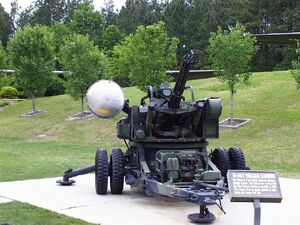
M167A2 VADS.
The Vulcan Air Defense System was developed alongside the AIM-9 Sidewinder-based MIM-72 Chaparral as stop-gap air defense systems following the collapse of the overly ambitious MIM-46 Mauler SAM project in 1965. The towed M167 VADS replaced the M2 Browning-based M45 Quadmount in 1967, while the M113-mounted M163 VADS replaced the 40mm Bofors L/60-based M42 Duster in 1969.
VADS is a manually aimed system in a power-assisted mounting: while it has an integral radar, this is only a rangefinder. VADS fires a specially developed high explosive incendiary tracer, self destruct (HEIT-SD) round. The system uses electrical power: the M163 draws power from the host M113 APC, while the M167 can either be powered with a generator or its own integral auxiliary power unit (APU). The gun on both VADS systems had a selectable 1,000 rpm fire rate for direct-fire against ground targets and 3,000 rpm for air targets: effective range was around three quarters of a mile against aircraft and 1.25 miles against ground targets.
VADS was known to be obsolete by the late 1970s due to Soviet helicopters equipped with the 9K114 Shturm (NATO: AT-6 Spiral) being able to target the system at almost five times its effective range, but due to the failure of the DIVADS (DIVisional Air Defense System) program's M247 Sergeant York and the FAAD (Forward Area Air Defense) program's multirole ADATS (Air Defense Anti-Tank System), it was not directly replaced in service until the adoption of the AN/TWQ-1 Avenger in 1994: however, by this point the man-portable FIM-92 Stinger had essentially replaced it operationally.
Phalanx[]
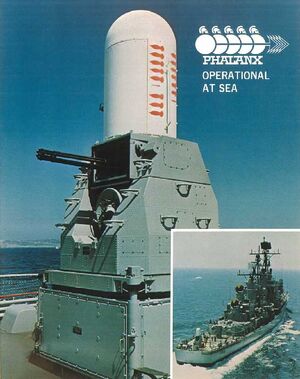
1973 Phalanx prototype on USS King (DLG-10).
Phalanx is a M61A1-based close-in weapon system (CIWS, pronounced "sea-whiz") developed in a partnership between General Dynamics and Raytheon for naval use in the 1970s, as the threat of anti-ship missiles became clear. The first Phalanx prototype was tested on the Farragut-class destroyer USS King (at the time DLG-10) in 1973. A second prototype was mounted on the hulked Allen M. Sumner-class destroyer USS Alfred A. Cunningham (DD-752) in 1975, and the hulk subject to several live attacks from missiles and guided bombs (including at least one AGM-62 Walleye) with the Phalanx shooting down every one. Further operational testing was carried out in 1977 with a prototype mounted on the Forrest Sherman-class destroyer USS Bigelow (DD-942), which found the system exceeded the reliability and maintenance goals set for it and performed well even in high radar clutter enviroments. The first operational Phalanx Block 0 was fitted to the Midway-class aircraft carrier USS Coral Sea (CVA-43) in 1980.
Phalanx installations are mounted to the outside of a ship's armor and are largely self-contained, only requiring a 440 volt three-phase 60 Hz AC power supply and a salt water inlet pipe for cooling their internal electronics. The Block 1B system requires 18 kilowatts of power in search mode and 70 in track mode. The installation has an additional input for the ship's true compass heading, though it does not require it. They are completely autonomous, with the operator's only required input being turning the system on or off.
The white domed upper section of the installation is the "weapon control group," containing the system's two Ku-band radars. In the upper domed portion is the digital MTI search radar, used for initial acquisition of targets, while the cylindrical section contains the pulse doppler mono-pulse tracking radar. The appearance of the mounting led to the system being nicknamed "R2-D2," sometimes with the addition "with a hard-on" due to the location of the gun.
Design details[]
The M61 Vulcan is a six-barrel rotary weapon with the common element being the gun body and barrels, with the drive and ammunition systems custom built to suit whatever it is mounted on. In its role as an aircraft cannon, the system is primarily designed for firing 1-second, 100-round bursts to create a dense volley of shots.
Like all guns based on Gatling's principles, fundamentally the operation of the Vulcan is bolt-action: each barrel has its own bolt group, which is cycled via a knob on the bolt that interfaces with cam paths in the gun housing. As the barrel group rotates, each bolt picks up a round, chambers, fires and extracts in sequence. In this way, each barrel only fires one-sixth of the total number of shots and spends five-sixths of its time cooling down.
The M61A1 switched to a linkless feed, and in aircraft applications is set up to cycle spent casings back into the ammunition storage drum rather than ejecting them. M61A1 ammunition is still issued in linked belts. When loading the ammunition drum, both feed chutes are detached from the drum, then a feeder/delinker is attached to the feeding port at the front of the magazine. If the weapon has been fired, a linker is fitted to the spent cartridge entry port at the back of the magazine, with a chute carrying links from the delinker to the linker. When loading, the drum is run in the opposite direction to how it normally operates, with new rounds cycled into the drum by the feeder, and expended casings cycling out and being linked into belts for easier transport.
Ammunition[]
The M61 Vulcan fires 20×102mm ammunition.
VADS used a specially developed round, the M246 high explosive incendiary tracer-self destruct (HEIT-SD). This round was designed to address worries about falling projectiles from the system exploding on impact with the ground, potentially injuring friendly troops or civilians, damaging structures, or causing fires. The M246 self-destructs roughly 4 seconds after firing at a range of approximately 1.12 miles (1,800 m). The later M940 multi-purpose incendiary tracer-self destruct (MPT-SD) is an improved variant which typically self-destructs after 4.5 seconds at a range of 1.43 miles (2,300 m). As both use a chemical fuze, the precise self-destruct time and range varies depending on ambient air temperature.
Phalanx was initially tested with standard ammunition (USN Mk 50) but quickly switched to a discarding sabot armor-piercing round: this used a .502 caliber (12.75mm) penetrator. The initial Mk 149 used a depleted uranium penetrator: this was changed to tungsten in 1988 with the adoption of the Mk 149-4, over concerns of environmental effects and crew exposure. The most recent version, the Mk 244 Mod 0 ELC (enhanced lethality cartridge) uses an optimized tungsten penetrator.
These rounds are not designed to directly destroy the target missile: rather, they are supposed to compromise its airframe to the point it is no longer capable of sustaining normal flight stresses and disintegrates.
Centurion C-RAM uses the same M246 HEIT-SD or M940 MPT-SD rounds as VADS.
Variants[]
M61[]
- M61
Original linked-feed version.
- M61A1

M61A1 gun body.
Linkless feed version.
- M61A2
Lightweight version developed for the Lockheed Martin F-22 Raptor and also used on the Boeing F/A-18E/F Super Hornet. Uses thinner barrels and lightweight materials, gun weight is 202 pounds (92 kg).
- GAU-4/M130
Version developed for gunpod mounts, used in the SUU-23/A gunpod, called M25 in US Army service. Uses an electric starting motor to spin up, then sustains itself by gas operation.
Scaled-down electrically powered "Mini-Vulcan" chambered for 7.62 mm NATO.
- M197
Three-barrel version developed for the AH-1 Cobra attack helicopter series. Much slower than the M61, firing at 750 to 1,500 rpm.
- XM301
Improved M197 developed for the RAH-66 Commanche, cancelled along with the RAH-66 program.
VADS[]
- M167 VADS
Towed version, weighing 2 tons and carrying 500 rounds of ammunition as standard. M167A1 featured unknown changes, the 1984 M167A2 Product Improved VADS (PIVADS) featured improved fire control and targeting systems, and added a second wheel on each side to prevent rollovers while being towed.
- M163 VADS
Variant mounted on an M113 APC, total weight 14 tons with 2,100 rounds of ammunition as standard. Also had an unknown A1 upgrade and a 1984 A2 upgrade which improved targeting and fire control.
Phalanx[]
- Phalanx Block 0
Original 1980 version. Somewhat unreliable (leading to sailors grumbling that CIWS meant "Captain, it won't shoot!"), suffered from seawater corrosion due to using a gun designed for aircraft, and had limited elevation and an awkward reloading procedure that took 20-30 minutes. Magazine held 989 rounds.
- Phalanx Block 1
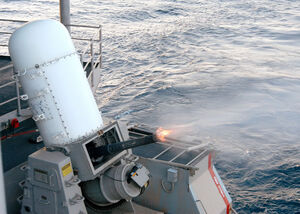
Block 1 Phalanx firing.
1988 upgrade, first operational unit fitted to the Iowa-class battleship USS Wisconsin (BB-64). Broad package designed to deal with shortcomings of the original system and address a new generation of Soviet supersonic anti-ship missiles. Higher-capacity magazine (1,550 rounds) redesigned for faster reloading (detaching and switching the drum rather than reloading it while attached), cutting the operation down to less than five minutes, replaced both radars, added corrosion-resistant barrels and increased maximum elevation to +70° to deal with missiles using terminal pop-up deck-attacking flight paths. Also switched to Mk 149-4 tungsten saboted armor-piercing round.
- Phalanx Block 1 Baseline 1
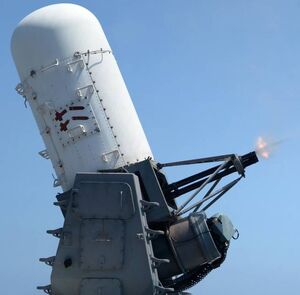
Phalanx Block 1 Baseline 2 or Block 1A. Note the barrel restraint.
1989 minor upgrade: switched the operation from hydraulic to pneumatic. Increased rate of fire from 3,000 to 4,500 rpm and reduced spin-up time from 0.5 seconds to almost zero.
- Phalanx Block 2
Initial plan for a successor model with unclear improvements, cancelled in 1992 in favour of continued incremental upgrades.
- Phalanx Block 1 Baseline 2
1995 minor upgrade: added a barrel restraint to improve accuracy.
- Phalanx Block 1A
1997, primarily a systems update: new high-order language computer systems better suited to engaging maneuvering targets, and integration with the Navy's Ship Self-Defense System, allowing Phalanx's radars to be used for targeting RIM-116 Rolling Airframe Missiles.
- Phalanx Block 1B
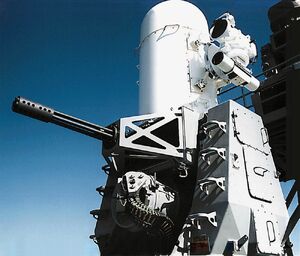
Phalanx Block 1B.
2000, first operational unit fitted to the Oliver Hazard Perry-class frigate USS Taylor (FFG-50) after a test unit was fitted to her sister USS Underwood (FFG-36) the year before. Broad upgrade, improved traversing speed, added a forward-looking infrared (FLIR) and video tracker on the left side of the weapon control group to increase effectiveness against surface targets, and swapped the L/76 gun barrels for L/99 Optimized Gun Barrels (OGB). Also introduced Mk 244 Mod 0 ELC ammunition.
- Centurion C-RAM
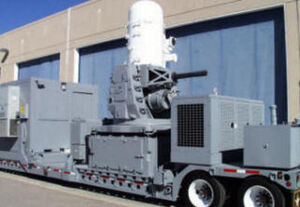
Early Centurion C-RAM on demountable trailer.
"Counter-Rocket, Artillery and Mortar." 2005 land-based Phalanx derivative based on the Block 1B variant designed to protect forward bases from rocket and mortar attacks. Uses ammunition developed for VADS. Original version was on a demountable towed trailer, later variant fits on the back of a HEMTT truck and is fully mobile.
- SEA RAM
Also written as SeaRAM. 2008 variant of Phalanx but not the M61: uses the Phalanx mounting but instead of a gun mounts an 11-tube RIM-116 Rolling Airframe Missile launcher.
